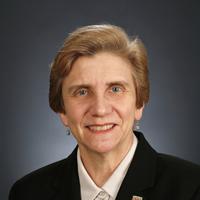
As most people know, paleontologists study the record of creatures that are no longer alive—the animals and plants of the dim past, extinct for millions of years. But just as long-gone life forms leave behind a testament of their existence in their fossilized remains, the environment in which that life existed leaves its own record, locked inside the ice, preserved for hundreds of thousands of years in Earth's glaciers. Dust, sediment, pollen, and other materials locked inside ancient ice can reveal the temperature fluctuations and atmospheric composition of earlier ages, just as the rings of a tree trunk tell the story of a tree's life. Studying the climatic history of Earth comprises the highly specialized discipline of paleoclimatology, and the husband and wife team of Lonnie Thompson and Ellen Mosley-Thompson are widely recognized as the world's preeminent experts in ice core sampling.
Raised in rural West Virginia, Lonnie Thompson studied physics at Marshall University, where he met Ellen Mosley, the only female student in the department at the time. A course in geology and an invitation by a professor to help do some field work swayed him over to earth science, and he graduated with a geology degree. After moving on to graduate school at Ohio State, he discovered paleoclimatology when he helped to analyze deep-ice samples from Antarctica and Greenland. He was fascinated by the stories preserved inside the polar ice, but soon began to realize that some pieces were missing. What about glaciers at lower latitudes, such as the Quelccaya ice cap in Peru? What secrets of the past did tropical ice hold that might be missed at the poles?
In 1974, Lonnie participated in the first expedition to the Quelccaya ice cap, and in 1983 became the first scientist to obtain ice core samples there. Because of the thin air and high altitude of the Andes, the feat demanded both technological and logistical innovations not required at polar sites, including the development of a solar-powered ice drill. The effort was worth it: Thompson's Quelccaya ice cores revealed new data on climate variability associated with El Niños, dry periods, and monsoon cycles in the tropics. He built on this work with further expeditions and sample collections from the Himalayas, Mount Kilimanjaro, and South America, as well as Antarctica and Greenland.
Meanwhile, while Lonnie was working at lower latitudes, Ellen was looking toward the poles. Changing from the study of physics, she obtained an M.A. and Ph.D. in geography at Ohio State University, with an emphasis on climatology and atmospheric science. Her Ph.D. work involved the analysis of an Antarctic ice core, and she soon found herself leading her own expeditions to both poles. Starting in the 1990s, she collected and studied ice cores from over 60 locations of the Greenland ice sheet, providing the most detailed picture of its climatic history, and is also known for seminal work regarding the impact of volcanic variability on climate. As director of the Byrd Polar Research Center at Ohio State University, she has been a tireless champion for polar and climatological research projects. Ellen has published scores of research papers on the findings of her ice core investigations, and has also co-authored most of Lonnie's research papers and collaborated with him closely on the chemical and isotopic analysis of his own ice core samples.
Together, the Thompsons have spent their careers piecing together the geological and climatological saga recorded and preserved in the glaciers and deep ice regions of our planet. They have become fierce advocates not only for science in general but for public and political efforts to address the global crisis of climate change, moved to action by the compelling and sobering picture of Earth's past and its possible future uncovered by their life's work. More than most people (including those whose vision fails to extend beyond the next election or fiscal cycle), they have witnessed the alarming changes taking place in Earth's environment "up close and personal," literally seeing and recording the rapid retreat of the world's icecaps and confirming that conditions are worsening at a rate far beyond any natural variations of past eras. Because their work has literally encompassed the entire world, the harbingers of climatic change revealed by their ice cores can't be idly dismissed as minor phenomena limited only to isolated areas. Lonnie first spoke publicly on global warming in 1992, and he and Ellen have since devoted much effort to raising public awareness of the problem, even testifying before Congress and serving as advisors on the Academy-Award-winning 2006 documentary An Inconvenient Truth.
Both independently and as a unique scientific team, Lonnie Thompson and Ellen Mosley-Thompson have helped to transform paleoclimatology from a relatively small subdiscipline of geology into a full-fledged science in its own right. Their work not only opens exciting new windows on our planet's past, but holds vitally important implications for the present and future of all life on Earth.
Information as of April 2012

